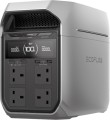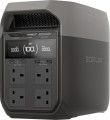Add to comparison |  |  |
|---|---|---|
| EcoFlow DELTA 3 Plus | EcoFlow DELTA 3 | |
| Compare prices 6 | Compare prices 11 | |
| TOP sellers | ||
| In box | charging station | charging station |
| Rated power | 1800 W | 1800 W |
| Peak power | 3600 W | 3600 W |
| Output waveform | sinusoid (PSW) | sinusoid (PSW) |
| UPS function | ||
Outputs | ||
| Sockets (230 V) | 4 | 4 |
| USB A (quick charge) | 2 36 W | 2 5В/2.4A, 9В/2A, 12В/1.5A 18 W |
| USB C | 2 3 A, 5 A 140 W | 2 3 A, 5 A 100 W |
| Car cigarette lighter | ||
Inputs (station charging) | ||
| From solar panels | ||
| Input port XT60 | ||
| Add. ports | Extra Battery Port | Extra Battery Port |
Battery and charging time | ||
| Connecting an additional battery | ||
| Battery type | LiFePO4 | LiFePO4 |
| Battery capacity | 1024 W*h | 1024 W*h |
| Charging cycles | 4000 | 4000 |
| Charging time (socket) ≈ | 56 min | 60 min |
| Charging time (solar panel) ≈ | 70 min | 130 min |
| Charging power (socket) | 1500 W | 1500 W |
| Charging power (solar panel) | 1000 W | 500 W |
General | ||
| Smartphone synchronization | Bluetooth and WiFi | Bluetooth and WiFi |
| PSU | built into the body | built into the body |
| Display | ||
| Carrying handle | ||
| Operating temperature | 0 °C ~ +45 °C | 0 °C ~ +45 °C |
| Dimensions | 398x202x284 mm | 398x202x284 mm |
| Weight | 12.5 kg | 12.5 kg |
| Warranty | 5 years | 5 years |
| Added to E-Catalog | november 2024 | november 2024 |
Both charging stations, EcoFlow DELTA 3 Plus and EcoFlow DELTA 3, have the same rated and peak power (1800W and 3600W respectively), as well as support for a sine wave output and UPS function. However, the DELTA 3 Plus offers more powerful outputs: 140W compared to 100W for the DELTA 3, making it more suitable for connecting more demanding devices. The charging time from solar panels also differs: DELTA 3 Plus charges faster (70 minutes when using two panels), whereas DELTA 3 requires about 130 minutes. Both devices have the same battery capacity (20 Ah) and lifespan (4000 cycles), as well as the same dimensions and weight. Overall, the EcoFlow DELTA 3 Plus is a more powerful and faster-charging model, which can be a decisive factor for users in need of high performance.